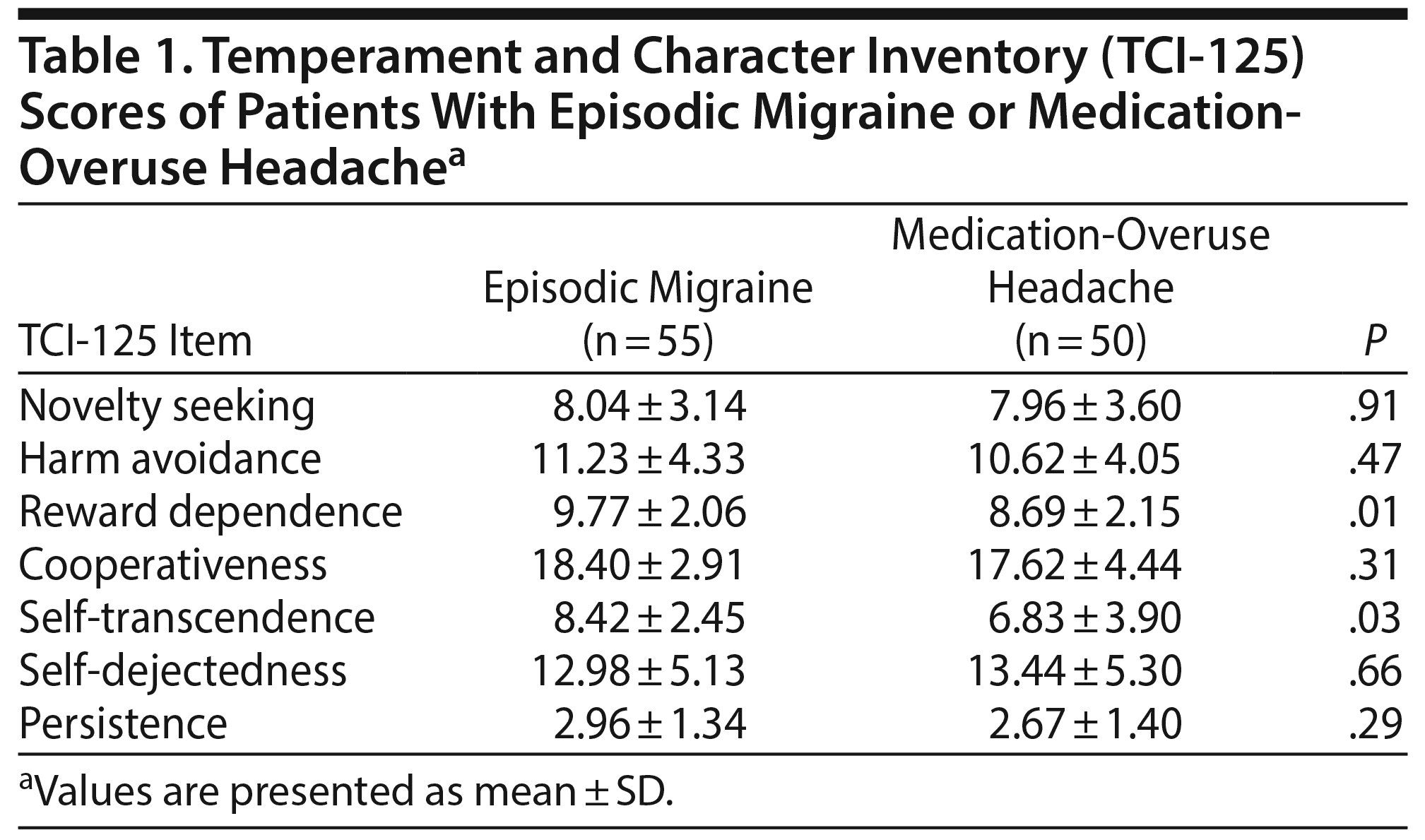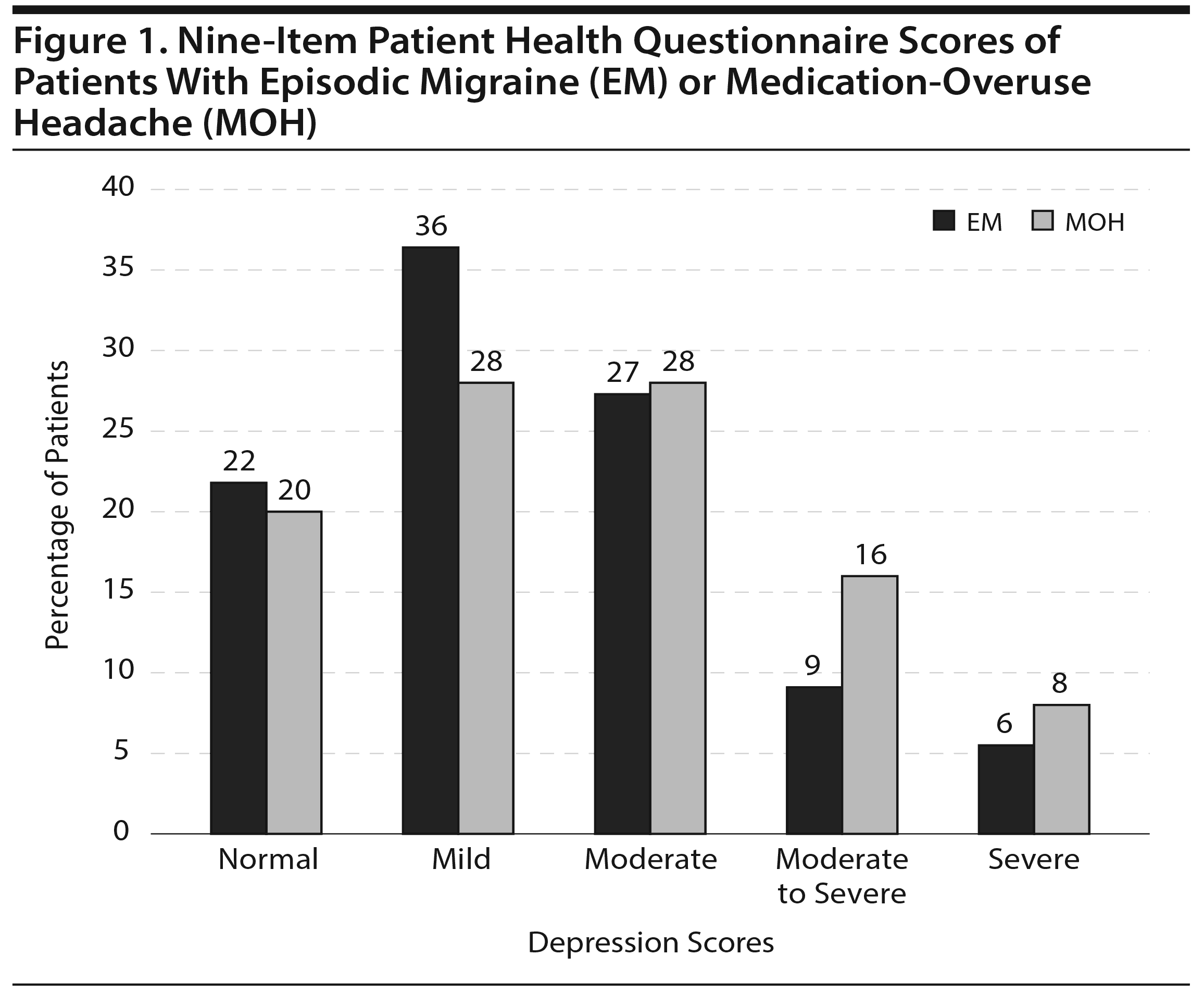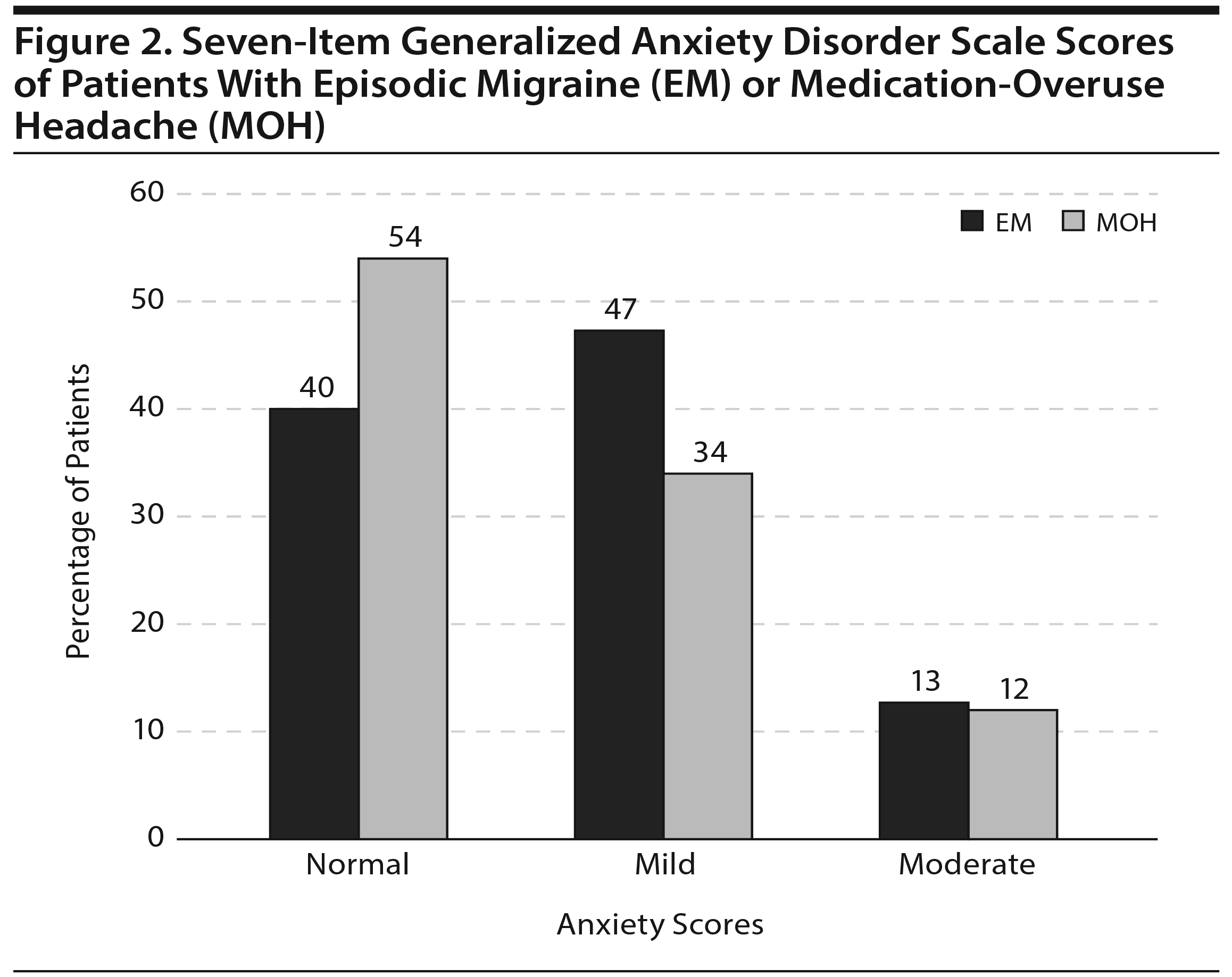Objective: An episodic migraine (EM) may lead to medication-overuse headache (MOH), an abnormal behavioral pattern of noncompliance. Anxiety disorders, mood disorders, and disorders caused by psychoactive substances other than analgesics all have been reported with MOH at higher rates than with EM. The objective of this study was to evaluate the relationships between personality traits and anxiety and depressive disorders and headache type.
Methods: In this cross-sectional study, 55 patients with EM and 50 patients with MOH were recruited from were recruited from 2 university hospital clinics in Tehran, Iran, from January 2013 to November 2015. Personality traits were assessed with the Temperament and Character Inventory (TCI-125). Patients were assessed for depression with the 9-item Patient Health Questionnaire (PHQ-9) and anxiety with the 7-item Generalized Anxiety Disorder scale (GAD-7).
Results: There was no significant difference between the 2 groups regarding sex, age, or educational level. The TCI-125 analysis between the 2 groups showed a significant mean ± SD difference in reward dependence (EM: 9.77 ± 2.06, MOH: 8.69 ± 2.15, P = .01) and self-transcendence (EM: 8.42 ± 2.45, MOH: 6.83 ± 3.90, P = .03). The GAD-7 and PHQ-9 analyses demonstrated no significant difference between the 2 groups.
Conclusions: Reward-dependence and self-transcendence scores were significantly lower in patients with MOH than in those with EM. These results suggest that people with lower reward-dependence and self-transcendence scores may not adequately respond to prescribed medications, leading them to the frequent use of multiple drugs at higher doses. A multidisciplinary approach to management may be suggested for migraine patients, and it is reasonable to consider behavioral therapy in conjunction with pharmacotherapy to ameliorate comorbid conditions.
Personality Traits and Anxiety and Depressive Disorders
in Patients With Medication-Overuse Headache
Versus Episodic Migraine
ABSTRACT
Objective: An episodic migraine (EM) may lead to medication-overuse headache (MOH), an abnormal behavioral pattern of noncompliance. Anxiety disorders, mood disorders, and disorders caused by psychoactive substances other than analgesics all have been reported with MOH at higher rates than with EM. The objective of this study was to evaluate the relationships between personality traits and anxiety and depressive disorders and headache type.
Methods: In this cross-sectional study, 55 patients with EM and 50 patients with MOH were recruited from were recruited from 2 university hospital clinics in Tehran, Iran, from January 2013 to November 2015. Personality traits were assessed with the Temperament and Character Inventory (TCI-125). Patients were assessed for depression with the 9-item Patient Health Questionnaire (PHQ-9) and anxiety with the 7-item Generalized Anxiety Disorder scale (GAD-7).
Results: There was no significant difference between the 2 groups regarding sex, age, or educational level. The TCI-125 analysis between the 2 groups showed a significant mean ± SD difference in reward dependence (EM: 9.77 ± 2.06, MOH: 8.69 ± 2.15, P = .01) and self-transcendence (EM: 8.42 ± 2.45, MOH: 6.83 ± 3.90, P = .03). The GAD-7 and PHQ-9 analyses demonstrated no significant difference between the 2 groups.
Conclusions: Reward-dependence and self-transcendence scores were significantly lower in patients with MOH than in those with EM. These results suggest that people with lower reward-dependence and self-transcendence scores may not adequately respond to prescribed medications, leading them to the frequent use of multiple drugs at higher doses. A multidisciplinary approach to management may be suggested for migraine patients, and it is reasonable to consider behavioral therapy in conjunction with pharmacotherapy to ameliorate comorbid conditions.
Prim Care Companion CNS Disord 2017;19(6):17m02188
https://doi.org/10.4088/PCC.17m02188
© Copyright 2017 Physicians Postgraduate Press, Inc.
aTehran University of Medical Sciences, Tehran, Iran
bDepartment of Neurology, Tehran University of Medical Sciences, Tehran, Iran
cElderly Health Research Center, Endocrinology and Metabolism Population Science Institute, Tehran University of Medical Sciences, Tehran, Iran
dDepartment of Neurology, Iranian Center of Neurological Research, Shariati Hospital, Tehran University of Medical Sciences, Tehran, Iran
*Corresponding author: Farzad Fatehi, MD, Iranian Center of Neurological Research, Shariati Hospital, North Kargar St, Tehran University of Medical Sciences, Tehran, Iran 14117-13135 ([email protected]).
Migraine is a debilitating headache disorder, including both episodic and chronic types, associated with a broad range of psychiatric comorbidities.1 Migraine affects around 15% of the population and approximately one-fifth of women.2 Since there are no biological markers for migraine, diagnosis is based on clinical history and the omission of other headache disorders.2
Episodic migraine (EM) is characterized by 0 to 14 headache days per month. Medication-overuse headache (MOH) is characterized by ≥ 15 headache days per month in patients taking ≥ 1 drug(s) for acute or symptomatic treatment of headache for ≥ 3 months in whom headache has developed or markedly worsened during medication overuse.3 In MOH patients, headache resolves or reverts to its previous pattern within 2 months after discontinuation of the overused medication.3 Use of migraine medications commonly causes MOH.2 According to epidemiologic studies, 4 progression from EM to MOH occurs each year in about 1 in 40 patients. Regardless of progression in migraine treatment, the prevalence of chronic headaches and especially MOH has not changed. Many migraine patients seek treatment from expert physicians and receive all classes of prophylactic treatment with no benefit.5
Anxiety disorders, mood disorders, and disorders caused by psychoactive substances other than analgesics all have been reported with MOH and chronic migraine at higher rates than with EM.6–8 The aim of this study was to evaluate possible associations of personality traits and anxiety and depressive disorders with headache type.
METHODS
In this cross-sectional study, 105 consecutive outpatient subjects with headache (EM: n=55, MOH: n=50) were recruited from 2 university hospital clinics of Tehran University of Medical Sciences from January 2013 to November 2015. Migraine was diagnosed and categorized by type according to International Classification of Headache Disorders Revised Criteria for Chronic Migraine9 by expert neurologists in the field of headache (M.T., F.F.).
Subjects
Patients were between the ages of 18 and 50 years and had no other chronic or serious illness. The study protocol was explained to all patients, and a signed consent form was received from each participant.
Patients with the following were excluded from the study: mental retardation; dementia; illiteracy; serious neurologic, medical, or psychiatric disorders; imaging abnormality (on brain MRI or brain computed tomography); or a history of alcohol or illicit drug abuse. Patients who did not provide informed consent and those with no definite diagnosis of migraine headache were also excluded.
Migraine Type
EM was defined as those with migraine who had 0 to 14 headache days per month. MOH was defined as ≥15 headache days per month in those taking ≥1 medication(s) for acute or symptomatic treatment of headache for ≥3 months and headache had developed or markedly worsened during medication overuse.3
Assessment Tools
Personality traits were evaluated with the Temperament and Character Inventory (TCI-125),10 and depressive and anxiety disorders were assessed with the 9-item Patient Health Questionnaire (PHQ-9) and the 7-item Generalized Anxiety Disorder scale (GAD-7), respectively.
TCI-125. The TCI-125 contains 125 yes or no questions and consists of 4 temperaments (novelty seeking, harm avoidance, reward dependence, and persistence) and 3 character dimensions (cooperativeness, self-directedness, and self-transcendence). Patients filled out the questionnaires under the supervision of a trained physician (N.M., S.N.) during a headache-free period. We used the Persian validated version of the questionnaire.10
PHQ-9. The PHQ-9 is a self-administered questionnaire used to detect depression, especially in the primary care setting. PHQ-9 scores classify depression as 0–4 (no depression), 5–9 (mild depression), 10–14 (moderate depression), 15–19 (moderately severe depression), and 20–27 (severe depression).11
GAD-7. The GAD-7 is a self-report questionnaire that measures the frequency of 7 anxiety symptoms according to the response categories not at all, several days, more than half the days, and nearly every day.12,13 On the basis of the patient’s answers, anxiety is classified as 0–4 (normal), 5–9 (mild anxiety), 10–14 (moderate anxiety), and 15–21 (severe anxiety). Evidence supports the reliability and validity of the GAD-7 as a measure of anxiety in the general population.14
Study Approval
Participation was voluntary and confidential, and the goals of the study were described before enrollment. The Ethics Committee of Tehran University of Medical Sciences approved the study. All subjects were given their test results.
Statistical Analysis
We used SPSS software version 19.0 for Windows to analyze the data. Continuous data are presented as mean ± SD. Additionally, we used the Kolmogorov-Smirnov Z test to determine the normal distribution of all continuous variables. Due to normal distribution of age and TCI-125 items, we used parametrical tests. We used χ2 to compare PHQ-9 and GAD-7 scores between the 2 groups.
To analyze personality traits, we used t test to compare scores for each trait between the 2 groups. The significance level was defined as P< .05.
RESULTS
The mean ± SD age of patients with EM was 36.6 ± 10.9 versus 39.4 ± 10.1 years in those with MOH (P = .79). The 2 groups did not differ significantly with respect to sex (EM: 45 women and 10 men, MOH: 42 women and 8 men, P = .77) or educational level (χ2 = 0.48, P = .79).
The TCI-125 analysis demonstrated a significant difference between the 2 groups for reward dependence (EM: 9.77 ± 2.06, MOH: 8.69 ± 2.15, P = .01) and self-transcendence (EM: 8.42 ± 2.45, MOH: 6.83 ± 3.90, P = .03) (Table 1). However, we found no significant difference for novelty seeking, harm avoidance, persistence, self-dejectedness, or cooperativeness (Table 1). In addition, there was no significant difference between the 2 groups in PHQ-9 (χ2 = 0.88, P = .76) (Figure 1) or GAD-7 (χ2 = 3.03, P = .22) scores (Figure 2).



DISCUSSION
Our results showed lower scores for reward dependence and self-transcendence in patients with MOH than in those with EM. In addition, the 2 groups did not differ significantly with respect to sex or educational level, indicating that these variables do not have a strong effect on transitioning from EM to MOH.
It is noticeable that we found no significant difference in anxiety and depression scores between the 2 groups, which possibly is a result of antidepressant use; however, it has been suggested that EM and MOH patients experience depression and anxiety at higher rates than the general population.15,16 Saper and Lake17 found higher rates of depression and anxiety in MOH patients than in those with EM, suggesting that in the MOH group, psychiatric disorders occur more often before the transition from EM to MOH. However, some studies18 showed no significant difference.
Reward dependence is defined as the tendency to positively respond to reward signals to maintain or resist behavioral extinction and the inclination to maintain ongoing behaviors that have been associated
with reinforcement in the past. Reward dependence is attributed to the serotonin-norepinephrine neurotransmitter pathway.19,20 On the other hand, self-transcendence is associated with spirituality and refers to identification of everything conceived to be an essential and consequential part of a unified whole world.21,22
Our finding of significantly higher scores for reward dependence and self-transcendence in EM patients than in those with MOH may suggest that MOH patients are individuals with chronic headaches who are not necessarily dependent on the medications but typically add new drugs to see if a change will occur. Also, those with lower scores on self-transcendence tend to be more materialistic, pragmatic, objective, controlling, and pretentious, which may justify self-medication behavior.23 On the other hand, people with lower reward-dependence scores are not sensitive enough to social norms; in other words, those with low reward dependence are more independent, which may justify self-medication behaviors. It is acceptable to think of the MOH patient as an individual who does not heed advice regarding his or her illness.
In contrast, when coupled with high self-directedness and cooperativeness, high self-transcendence indicates maturity, spirituality, and creativity rather than psychopathology.24 Furthermore, we know that patients with migraine have higher scores on harm avoidance and persistence and lower scores on self-directedness compared with a random general population.25 Migraine patients with comorbid bipolar disorders are more susceptible to transition to MOH patients who do not respond as well to pharmacologic treatment.26 These results are in contrast with those of our study that showed self-transcendence rates to be higher in EM patients then in those with MOH. It is significant that in a study27 that included patients with EM (n = 79), chronic migraine (n = 28), and MOH (n = 31), harm-avoidance scores were significantly higher in the 3 migraine groups than in the control group. In addition, among the 3 groups, harm-avoidance scores were highest in MOH patients.27
In patients with low reward-dependence scores, treatment with serotonin-norepinephrine agents is suggested. Behavioral therapy regarding self-medication behavior control must also be considered in high-risk patients in conjunction with both psychiatrists and behavior therapists.
The main limitation of this study was the small sample size. In the future, we suggest that studies incorporate larger sample sizes and adherence and compliance assessments.
In conclusion, our study showed significantly lower scores of reward dependence and self-transcendence in MOH patients compared with EM patients. It is suggested that people with lower reward-dependence and self-transcendence scores may not adequately respond to the medications prescribed by their physician, leading them to the frequent use of multiple drugs at higher doses. Assessment of personality traits in EM patients may predict this progression, and a multidisciplinary approach to care is warranted for high-risk patients.
Submitted: June 29, 2017; accepted September 29, 2017.
Published online: December 14, 2017.
Potential conflicts of interest: None.
Funding/support: None.
REFERENCES
1. Minen MT, Begasse De Dhaem O, Kroon Van Diest A, et al. Migraine and its psychiatric comorbidities. J Neurol Neurosurg Psychiatry. 2016;87(7):741–749. PubMed CrossRef
2. Katsarava Z, Buse DC, Manack AN, et al. Defining the differences between episodic migraine and chronic migraine. Curr Pain Headache Rep. 2012;16(1):86–92. PubMed CrossRef
3. Olesen J, Bousser M-G, Diener H-C, et al. New appendix criteria open for a broader concept of chronic migraine. Cephalalgia. 2006;26(6):742–746. PubMed CrossRef
4. Bigal ME, Serrano D, Buse D, et al. Acute migraine medications and evolution from episodic to chronic migraine: a longitudinal population-based study. Headache. 2008;48(8):1157–1168. PubMed CrossRef
5. Ferrari A, Baraldi C, Sternieri E. Medication overuse and chronic migraine: a critical review according to clinical pharmacology. Expert Opin Drug Metab Toxicol. 2015;11(7):1127–1144. PubMed CrossRef
6. Radat F, Creac’h C, Swendsen JD, et al. Psychiatric comorbidity in the evolution from migraine to medication overuse headache. Cephalalgia. 2005;25(7):519–522. PubMed CrossRef
7. Cupini LM, De Murtas M, Costa C, et al. Obsessive-compulsive disorder and migraine with medication-overuse headache. Headache. 2009;49(7):1005–1013. PubMed CrossRef
8. Buse DC, Silberstein SD, Manack AN, et al. Psychiatric comorbidities of episodic and chronic migraine. J Neurol. 2013;260(8):1960–1969. PubMed CrossRef
9. Bigal ME, Rapoport AM, Sheftell FD, et al. The International Classification of Headache Disorders Revised Criteria for Chronic Migraine—field testing in a headache specialty clinic. Cephalalgia. 2007;27(3):230–234. PubMed CrossRef
10. Kaviani H, Poor Naseh M. Validation of Temperament and Character Inventory (TCI) in Iranian sample: normative data. Tehran Univ Med J. 2005;63(2):89–98.
11. Kroenke K, Spitzer RL, Williams JBW. The PHQ-9. J Gen Intern Med. 2001;16(9):606–613. PubMed CrossRef
12. Spitzer RL, Kroenke K, Williams JBW, et al. A brief measure for assessing generalized anxiety disorder: the GAD-7. Arch Intern Med. 2006;166(10):1092–1097. PubMed CrossRef
13. Swinson RP. The GAD-7 scale was accurate for diagnosing generalized anxiety disorder. Evid Based Med. 2006;11(6):184. PubMed CrossRef
14. Löwe B, Decker O, Müller S, et al. Validation and standardization of the Generalized Anxiety Disorder Screener (GAD-7) in the general population. Med Care. 2008;46(3):266–274. PubMed CrossRef
15. Lantéri-Minet M, Radat F, Chautard M-H, et al. Anxiety and depression associated with migraine: influence on migraine subjects’ disability and quality of life, and acute migraine management. Pain. 2005;118(3):319–326. PubMed CrossRef
16. Karakurum B, Soylu O, Karataş M, et al. Personality, depression, and anxiety as risk factors for chronic migraine. Int J Neurosci. 2004;114(11):1391–1399. PubMed CrossRef
17. Saper JR, Lake AE. Borderline personality disorder and the chronic headache patient: review and management recommendations. Headache. 2002;42(7):663–674. PubMed CrossRef
18. Atasoy HT, Atasoy N, Unal AE, et al. Psychiatric comorbidity in medication overuse headache patients with pre-existing headache type of episodic tension-type headache. Eur J Pain. 2005;9(3):285–291. PubMed CrossRef
19. Comings DE, Gade-Andavolu R, Gonzalez N, et al. A multivariate analysis of 59 candidate genes in personality traits: the Temperament and Character Inventory. Clin Genet. 2000;58(5):375–385. PubMed CrossRef
20. Laricchiuta D, Petrosini L. Individual differences in response to positive and negative stimuli: endocannabinoid-based insight on approach and avoidance behaviors. Front Syst Neurosci. 2014;8:238. PubMed CrossRef
21. Hansenne M, Reggers J, Pinto E, et al. Temperament and Character Inventory (TCI) and depression. J Psychiatr Res. 1999;33(1):31–36. PubMed CrossRef
22. Kim J-H, Son Y-D, Kim J-H, et al. Self-transcendence trait and its relationship with in vivo serotonin transporter availability in brainstem raphe nuclei: an ultra-high resolution PET-MRI study. Brain Res. 2015;1629:63–71. PubMed CrossRef
23. DeLisi M, Beaver KM. Criminological Theory: A Life-Course Approach. Burlington, MA: Jones & Bartlett Learning; 2011:279.
24. Jylhä P, Ketokivi M, Mantere O, et al. Temperament, character and personality disorders. Eur Psychiatry. 2013;28(8):483–491. PubMed CrossRef
25. Mongini F, Fassino S, Rota E, et al. The Temperament and Character Inventory in women with migraine. J Headache Pain. 2005;6(4):247–249. PubMed CrossRef
26. Rothrock J, Lopez I, Zweilfer R, et al. Borderline personality disorder and migraine. Headache. 2007;47(1):22–26. PubMed CrossRef
27. Watanabe Y, Tateno H, Hirata K. Temperament and character profiles of patients with chronic migraine and medication-overuse headache. J Headache Pain. 2013;14(S1):178. CrossRef
Please sign in or purchase this PDF for $40.00.


